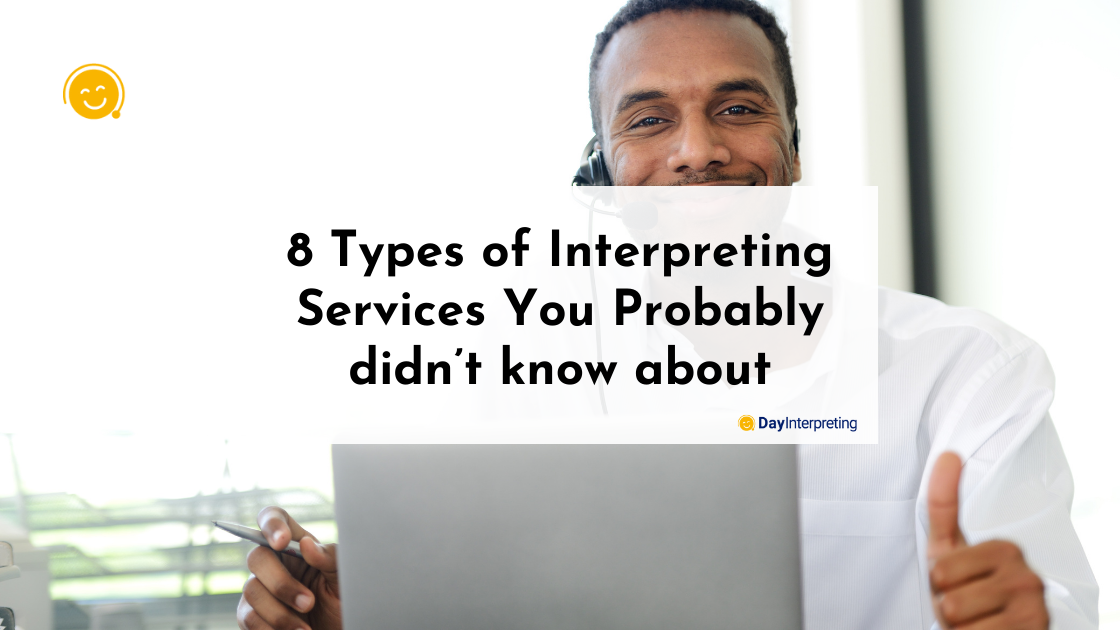Many people aren’t aware of the different types of interpreting services, much less know that there are 8 different types. Today our Day Interpreting blog tells you all about the different interpreting services so that you can understand which one you may need.
Defining Interpreting and Different Types of Interpreting Services
Before we dive into the different types of interpreting services, it’s always best to have a working definition and understanding of the term.
Interpreting is the process of understanding and translating the spoken word from one language (usually called the source language) to another language (usually called the target language).
The 8 Types of Interpreting Services
We’re now going to look in further detail at the different ways we can interpret the spoken word.
-
Simultaneous Interpreting
Simultaneous interpretation means that the interpreter translates the speech as it’s spoken. Therefore, what’s being said is instantly translated into the target language.
Of course, we must take into consideration the gap of time that it would take to understand the message since simultaneous interpreting doesn’t involve paraphrasing the content. This type of interpretation aims to convey the exact language. The moment the interpreter understands the general meaning of a sentence, interpretation begins.
On the part of the listener, requires them to keep up with the speaker, mentally translating as quickly and accurately as possible, with no time to overthink translations.
Simultaneous Interpreters have to be decisive. A delay, even a short one, could mean the loss of keywords needed to help the audience understand a reference.
It’s also important for the interpreter to count with the necessary audiovisual equipment to obtain an authentic interpretation. Everything from audio cabins, headphones, speaker systems, microphones, screens, and technical support available to solve any functional inconvenience, is crucial.
Simultaneous Interpretation is the most common interpretation service used at large events, such as conferences, crowded meetings, and trade shows. The United Nations General Assembly is a good example of an occasion where simultaneous interpreting is paramount. This also helps us to understand why this type of interpretation is commonly referred to as “Conference interpreting”.
-
Consecutive Interpreting
This type of interpreting doesn’t take place at the same time as the message is being transmitted in the source language. Instead, the interpreter repeats what was said in the target language only when the speaker pauses, with laps of 1 to 5 minutes before he or she continues speaking.
While the speaker is exposing a given topic, the interpreter takes notes in shorthand so that later on the full text can be translated accurately. This method of interpretation is more time-consuming than simultaneous interpretation because the speaker has to stop from time to time to allow the interpreter to reproduce the content in the language of the listeners (the target language). That’s why this interpretation style is preferred for small or bilateral meetings, interviews, meals, and even in court when a witness has to testify.
The differential skill that is employed as a consecutive interpreter is their sharpness in note-taking. This is so because of the difficulty involved in listening carefully without missing any detail while understanding the correct meaning behind each word.
-
Whisper Interpreting
Whisper interpreting is basically simultaneous interpreting only without any kind of equipment. For this method, the interpreter has to sit next to the listener and translate out loud. The difference comes in the tone of the interpreter’s voice. They are indeed translating out loud but very quietly, almost whispering, what the speaker is saying into the target language.
This interpretation style is also known as “chuchotage”, which stands for “whispering” in French. This would be the preferred method if it’s not possible to afford the necessary equipment for a simultaneous interpretation.
Aside from any budget-related concerns, whisper interpreting is chosen for its practicality. The interpretation can take place anywhere, and instantly.
It’s typically used for short presentations or meetings with a reduced number of attendees, where only one person needs interpreting. A good example is the visit of a foreign leader, who is going to need to understand and reply during political reunions.
-
Travel Interpreting
Also called “Escort” interpreting, Travel Interpreting is a service many business people and tourists use while on trips abroad. These interpreters accompany travelers not only for linguistic interpretation but also as cultural intermediaries who can explain a foreign culture to their client.
A Travel interpreter also works as a liaison between foreign speakers and their clients, translating both ways every time a conversation takes place. This means accompanying the client for several hours while going about their daily activities.
-
Over-the-Phone Interpreting (OPI or Scheduled Telephone Interpreting)
This interpretation method is hired when it’s unnecessary for the client to have an interpreter present at all times. The format can be either simultaneous or consecutive, according to the styles mentioned above.
The interpreter usually participates in the appointment from a phone, tablet, or computer. Even if it’s not necessary to meet both parties in person, having access to the visualization of the speakers is helpful in remote conversations. Any extra-linguistic sign helps to complete the communication process so that, when in doubt, the interpreter may offer a higher degree of accuracy.
Within this method, there’s “On-Demand Phone Interpreting”, which is for those cases where the call or meeting takes place immediately. There are services where people can select the two languages they need to translate, and they’re connected to an interpreter right away.
This is a very common method for medical practitioners and legal institutions that generally face interaction with LEP (limited English proficiency) population. They tend to be in need of an on-demand service available for unpredicted appointments. The downside of this fast access is that this interpreter doesn’t have access to any background information or context, which may have an impact on the quality of the interpretation. The fact of not being in-person also leaves out of scope the non-verbal communication.
-
Video Interpreting
Video remote interpreting is very similar to Over-the-phone Interpreting, with the only difference being that the conversation does not take place over the phone. Instead, the medium is video conferencing and it allows the interpreter to access all the non-verbal details the speaker is communicating. This guarantees more accuracy in the final message that’s transmitted.
-
Sworn Interpreting
Sworn Interpreting is the most used method in Court, notarial acts, or business meetings and involves the signing of agreements or Mergers and Acquisition between companies.
It works in a comparable way to liaison interpretation, but in this case, the translated content must be approved by a sworn interpreter appointed by a government agency. A Sworn Interpreter has to swear to everything that is being interpreted during the meeting, whether orally or drafted.
-
Sign Language Interpreting
Events and service providers must always consider the presence of the hearing impaired or hard-of-hearing demographic. They need sign language to communicate. This is where Sign language interpreters come in. A Sign Language Interpreter’s duty, for example, is to be receptive and guide their clients on case subtitles or captions as they are being presented at an event.
Let’s Wrap Up
You’re now more knowledgeable about the different types of interpreting services and what makes it even better is that you can now tell when and where you’ll need which type.
Of course, Day Interpreting caters to all your interpreting needs. What’s even better, you can download the Day Interpreting app to access on-demand interpreting services now you have everything you need to know about the interpretation options you’ll find. We offer excellent interpreting services that will suit you!





0 Comments